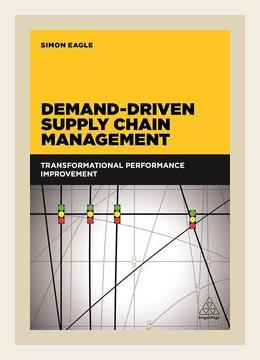Operations and Supply Chain ManagementOperations Strategy
Category: Operations Strategy
Introduction
Simon Eagle’s “Demand-Driven Supply Chain Management: Transformational Performance Improvement” emphasizes transforming traditional supply chains into more adaptive, demand-driven models. The book provides a comprehensive framework and actionable strategies for enabling these changes, addressing both theoretical concepts and practical implementations.
1. The Need for Transformation
Key Points:
- Traditional Supply Chain Challenges: Traditional methods often rely on forecasts and rigid plans, leading to inefficiencies such as high inventory levels, long lead times, and poor customer service.
- Market Volatility: Businesses face quickly changing customer demands and market conditions, rendering old supply strategies ineffective.
Example from the book:
- Retail Sector: Retailers using a forecast-driven approach often face stock-outs on trending items while being overstocked on outdated products.
Action:
- Adopt a Demand-Driven Approach: Begin by assessing your current supply chain’s performance and identify points where demand data can replace forecasts.
2. Demand-Driven MRP (DDMRP)
Key Points:
- DDMRP Principles: Combining traditional Material Requirements Planning (MRP) with lean and agility principles.
- Five Components of DDMRP:
- Strategic Inventory Positioning – Determine critical points for stocking.
- Buffer Profiles and Levels – Establish dynamic buffers.
- Dynamic Adjustments – Adjust buffers in real-time.
- Demand-Driven Planning – Use actual demand to drive supply.
- Visible and Collaborative Execution – Ensure visibility and collaboration across the supply chain.
Example from the book:
- Auto Industry: By implementing DDMRP, an automotive supplier reduced lead times and inventory levels while improving service rates.
Action:
- Implement DDMRP: Start with a pilot project in a specific segment of your supply chain, applying all five components of DDMRP.
3. Benefits of Demand-Driven Supply Chain
Key Points:
- Improved Customer Service: Better responsiveness to market changes.
- Reduced Inventory Levels: More accurate alignment with true demand.
- Increased Efficiency: Reduced lead times and waste.
Example from the book:
- Electronics Manufacturer: A company improved order fulfillment rates from 80% to 95% while cutting inventory by 30%.
Action:
- Measure and Track Benefits: Implement metrics to continuously monitor improvements in service levels, inventory costs, and overall efficiency to sustain momentum.
4. Strategic Inventory Positioning
Key Points:
- Critical Inventory Decisions: Identify the strategic points where inventory should be held.
- Decoupling Points: Locations in the supply chain where variability can be isolated.
Example from the book:
- Food and Beverage Industry: A company strategically positioned buffers at its regional distribution centers, reducing stock-outs and enhancing flexibility.
Action:
- Identify Decoupling Points: Analyze your supply chain to find where to hold strategic inventories to smooth out fluctuations.
5. Real-Time Data Utilization
Key Points:
- Role of Technology: Leveraging technology for real-time data collection and analysis.
- Demand Signals: Use point-of-sale (POS) data and other direct demand signals to drive supply chain activities.
Example from the book:
- Fast Fashion Retailer: Utilized RFID technology to track sales in real-time, adjusting production schedules and inventory levels accordingly.
Action:
- Invest in Technology: Implement software solutions that provide real-time visibility into demand and supply chain operations.
6. Responsive and Collaborative Framework
Key Points:
- Cross-Functional Teams: Foster collaboration between departments such as sales, production, and logistics.
- Supplier Collaboration: Engage and align with suppliers to enhance responsiveness.
Example from the book:
- Automotive Parts Supplier: Formed cross-functional teams to address supply chain issues, resulting in quicker problem resolution and improved lead times.
Action:
- Build Teams: Establish cross-functional and supplier collaboration frameworks to ensure that information flows seamlessly across the supply chain.
7. Organizational Change and Training
Key Points:
- Cultural Shift: Cultivate a mindset within the organization that embraces change and continuous improvement.
- Skill Development: Provide training on demand-driven principles and tools.
Example from the book:
- Consumer Goods Company: Conducted workshops and training programs to build understanding and skills for DDMRP implementation, leading to smoother transitions and better adoption.
Action:
- Facilitate Training: Develop and implement a training program focused on demand-driven supply chain principles and methodologies.
8. Performance Measurement and Continuous Improvement
Key Points:
- KPIs for Measurement: Define and track metrics such as inventory turnover, service levels, and response times.
- Iterative Improvement: Use performance data to drive ongoing enhancements.
Example from the book:
- Industrial Equipment Manufacturer: Established performance metrics that highlighted underperforming areas, leading to targeted improvements and sustained performance gains.
Action:
- Set KPIs: Identify key performance indicators relevant to your supply chain and implement a continuous monitoring and improvement process.
9. Case Studies and Success Stories
Key Points:
- Real-World Implementations: Detailed case studies of organizations that have successfully transformed their supply chains using demand-driven principles.
- Lessons Learned: Insights and best practices gathered from various industries.
Example from the book:
- Healthcare Supply Chain: A hospital network reduced medical supply costs and improved delivery by implementing demand-driven strategies.
Action:
- Learn from Others: Study case studies relevant to your industry and identify best practices you can apply to your supply chain transformation efforts.
Conclusion
Simon Eagle’s “Demand-Driven Supply Chain Management” provides a structured blueprint for transforming supply chains to become more responsive and efficient. By integrating demand-driven principles, businesses can better adapt to market variances, reduce waste, and ultimately improve service levels. Implementing practical actions from each key concept can guide organizations through the journey towards a demand-driven supply chain.
This summary captures the essence and actionable insights from “Demand-Driven Supply Chain Management: Transformational Performance Improvement”, offering a condensed yet detailed overview to aid in understanding and implementing its principles effectively.
